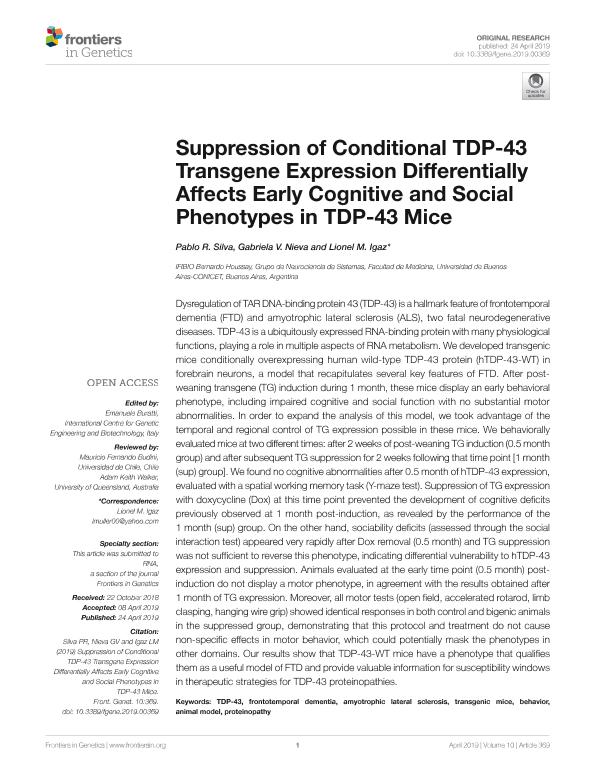Mostrar el registro sencillo del ítem
dc.contributor.author
Silva Pinto, Pablo Roberto

dc.contributor.author
Nieva, Gabriela Verónica

dc.contributor.author
Müller Igaz, Lionel Ivan

dc.date.available
2020-12-18T12:53:07Z
dc.date.issued
2019-04
dc.identifier.citation
Silva Pinto, Pablo Roberto; Nieva, Gabriela Verónica; Müller Igaz, Lionel Ivan; Suppression of conditional TDP-43 transgene expression differentially affects early cognitive and social phenotypes in TDP-43 mice; Frontiers Media S.A.; Frontiers in Genetics; 10; 4-2019; 1-13
dc.identifier.issn
1664-8021
dc.identifier.uri
http://hdl.handle.net/11336/120823
dc.description.abstract
Dysregulation of TAR DNA-binding protein 43 (TDP-43) is a hallmark feature of frontotemporal dementia (FTD) and amyotrophic lateral sclerosis (ALS), two fatal neurodegenerative diseases. TDP-43 is a ubiquitously expressed RNA-binding protein with many physiological functions, playing a role in multiple aspects of RNA metabolism. We developed transgenic mice conditionally overexpressing human wild-type TDP-43 protein (hTDP-43-WT) in forebrain neurons, a model that recapitulates several key features of FTD. After post-weaning transgene (TG) induction during 1 month, these mice display an early behavioral phenotype, including impaired cognitive and social function with no substantial motor abnormalities. In order to expand the analysis of this model, we took advantage of the temporal and regional control of TG expression possible in these mice. We behaviorally evaluated mice at two different times: after 2 weeks of post-weaning TG induction (0.5 month group) and after subsequent TG suppression for 2 weeks following that time point [1 month (sup) group]. We found no cognitive abnormalities after 0.5 month of hTDP-43 expression, evaluated with a spatial working memory task (Y-maze test). Suppression of TG expression with doxycycline (Dox) at this time point prevented the development of cognitive deficits previously observed at 1 month post-induction, as revealed by the performance of the 1 month (sup) group. On the other hand, sociability deficits (assessed through the social interaction test) appeared very rapidly after Dox removal (0.5 month) and TG suppression was not sufficient to reverse this phenotype, indicating differential vulnerability to hTDP-43 expression and suppression. Animals evaluated at the early time point (0.5 month) post-induction do not display a motor phenotype, in agreement with the results obtained after 1 month of TG expression. Moreover, all motor tests (open field, accelerated rotarod, limb clasping, hanging wire grip) showed identical responses in both control and bigenic animals in the suppressed group, demonstrating that this protocol and treatment do not cause non-specific effects in motor behavior, which could potentially mask the phenotypes in other domains. Our results show that TDP-43-WT mice have a phenotype that qualifies them as a useful model of FTD and provide valuable information for susceptibility windows in therapeutic strategies for TDP-43 proteinopathies.
dc.format
application/pdf
dc.language.iso
eng
dc.publisher
Frontiers Media S.A.

dc.rights
info:eu-repo/semantics/openAccess
dc.rights.uri
https://creativecommons.org/licenses/by/2.5/ar/
dc.subject
AMYOTROPHIC LATERAL SCLEROSIS
dc.subject
ANIMAL MODEL
dc.subject
BEHAVIOR
dc.subject
FRONTOTEMPORAL DEMENTIA
dc.subject
PROTEINOPATHY
dc.subject
TDP-43
dc.subject
TRANSGENIC MICE
dc.subject.classification
Neurociencias

dc.subject.classification
Medicina Básica

dc.subject.classification
CIENCIAS MÉDICAS Y DE LA SALUD

dc.title
Suppression of conditional TDP-43 transgene expression differentially affects early cognitive and social phenotypes in TDP-43 mice
dc.type
info:eu-repo/semantics/article
dc.type
info:ar-repo/semantics/artículo
dc.type
info:eu-repo/semantics/publishedVersion
dc.date.updated
2020-11-19T21:38:54Z
dc.journal.volume
10
dc.journal.pagination
1-13
dc.journal.pais
Suiza

dc.description.fil
Fil: Silva Pinto, Pablo Roberto. Consejo Nacional de Investigaciones Científicas y Técnicas. Oficina de Coordinación Administrativa Houssay. Instituto de Fisiología y Biofísica Bernardo Houssay. Universidad de Buenos Aires. Facultad de Medicina. Instituto de Fisiología y Biofísica Bernardo Houssay; Argentina
dc.description.fil
Fil: Nieva, Gabriela Verónica. Consejo Nacional de Investigaciones Científicas y Técnicas. Oficina de Coordinación Administrativa Houssay. Instituto de Fisiología y Biofísica Bernardo Houssay. Universidad de Buenos Aires. Facultad de Medicina. Instituto de Fisiología y Biofísica Bernardo Houssay; Argentina
dc.description.fil
Fil: Müller Igaz, Lionel Ivan. Consejo Nacional de Investigaciones Científicas y Técnicas. Oficina de Coordinación Administrativa Houssay. Instituto de Fisiología y Biofísica Bernardo Houssay. Universidad de Buenos Aires. Facultad de Medicina. Instituto de Fisiología y Biofísica Bernardo Houssay; Argentina
dc.journal.title
Frontiers in Genetics
dc.relation.alternativeid
info:eu-repo/semantics/altIdentifier/url/https://www.frontiersin.org/article/10.3389/fgene.2019.00369/full
dc.relation.alternativeid
info:eu-repo/semantics/altIdentifier/doi/http://dx.doi.org/10.3389/fgene.2019.00369
Archivos asociados
